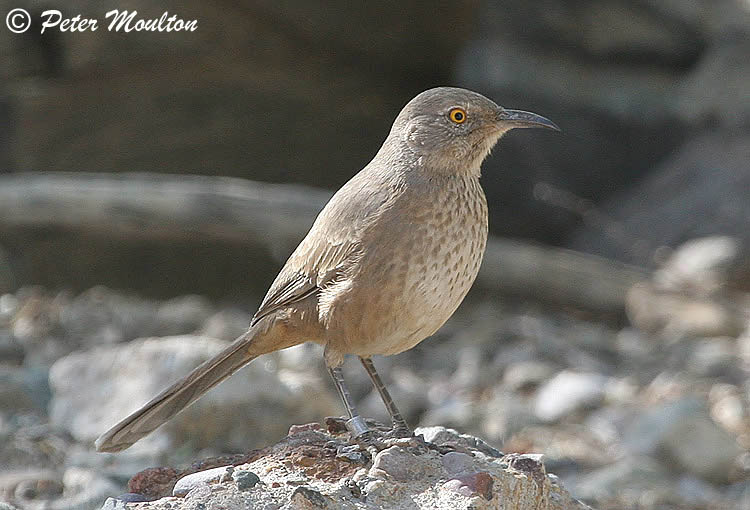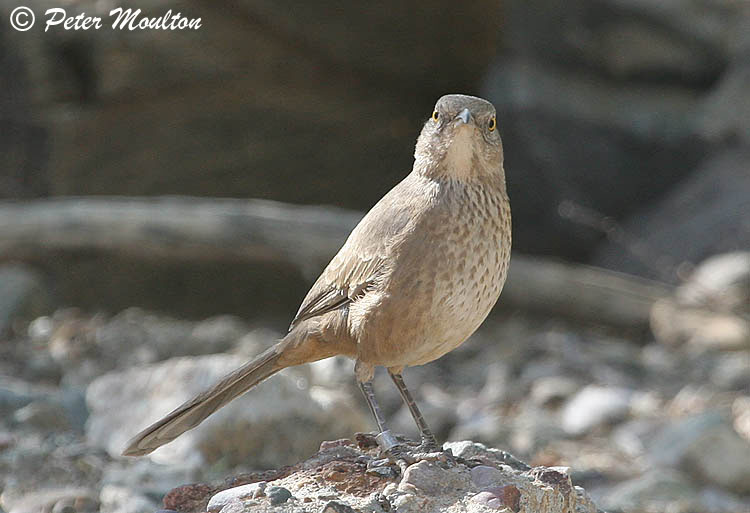
Bendire’s Thrasher
Toxostoma bendirei
BIOMETRICS:
Length: 23-25 cm ; Wingspan: 33-38 cm ; Weight: 60 g
LONGEVITY: up to 4 years
DESCRIPTION:
Bendire’s Thrasher is a medium-sized bird, with long tail at least as long as body or more. Upperparts are almost uniform olive-brown. We can see two indistinct whitish wing bars and white outer tail feathers.
Underparts are pale buff. Chest and sides are finely streaked with dusky triangular spots, less conspicuous in worn summer plumage. Undertail coverts are dark.
Head is grey brown to olive brown, with buff forehead, brown crown and olive green nape. Chin and throat are white.
Bill is down curved and relatively short, dark grey, with paler base on lower mandible. Eyes are yellow. Legs and feet are dark brown.
Both sexes are similar.
Juvenile has streaked head and back. Wing bars are slightly cinnamon. Underparts are finely marked with small dusky streaks.

We find two similar species:
Curve-billed Thrasher, with longer, curved dark bill, rounded spots on underparts and yellow-orange eyes.
Sage Thrasher is smaller, with shorter and straighter bill, with paler underparts heavily streaked on chest.
We find two subspecies, T.b. rubricatum and T.b. candidum, different in colour and range in Sonora.
VOICE: SOUNDS BY XENO-CANTO
Bendire’s Thrasher’s song is a clear, melodious warbler with frequent repetitions of phrases.
Calls include a low, dry, gruff “chek”, sometimes doubles “chuk-chek”.
HABITAT:
Bendire’s Thrasher lives in open farmlands, grasslands and brushy arid to semi-arid deserts, open country with scattered scrubs, cacti and hedges. It breeds mainly in grasslands, shrublands or woodlands. It is found from sea level to 1800 metres of elevation.
RANGE:
Bendire’s Thrasher breeds from southern California, to south west Colorado and to north western Mexico.
BEHAVIOUR:
Bendire’s Thrasher feeds on the ground, probing the soil to find insects. It also takes fruits from vegetation. It gleans in foliage for insects, and plucks fruits with its bill. Sometimes, it runs along vegetation, jumping up into the air as for catching insects.
Bendire’s Thrasher flies from bush to bush, but it feeds mainly on the ground, searching insects, seeds and berries, digging for prey, but it does not scratch with its feet. It walks or runs with cocked tail.
Bendire’s Thrashers are monogamous, and pair bonds are formed after singing courtship displays by the male. Song is delivered from high perch, and declines rapidly after breeding.
Territorial behaviour begins in mid-March to mid-June. They are solitary nesters.
Bendire’s Thrasher is a migratory species, moving south in post breeding. Populations of southern parts of the range are resident.
FLIGHT:
Bendire’s Thrasher flies with rapid wing beats, alternated with closed wings on body sides. It flies readily, on very long distances and relatively high.

REPRODUCTION:
Bendire’s Thrasher’s nest is usually located in a shrub, cactus or tree, at about 1 to 3 metres above the ground. The nest is an open bowl-shaped construction. The external structure is made with sticks, the cup is made with grass, and the interior is lined with softer materials such as animal hair and feathers. The nest may reach up to 30 cm in external diameter and 23 cm in high. The interior cup is smaller, about 6 to 9 cm in diameter and 4 to 9 cm in depth. Bendire’s Thrasher’s nest is usually smaller, finer and more compact than others Thrashers’ nests.
Female lays 3 to 4 pale greenish eggs, finely spotted with dark markings. Incubation lasts about 12 to 14 days, shared by both parents. The altricial chicks are fed by both adults, and fledge very soon, at 12 days of age. Young remain in family groups for a period of time thereafter.
This species produces two broods per year, occasionally three in Arizona and Sonora, from late February to late July.
DIET:
Bendire’s Thrasher feeds mainly on insects, such as grasshoppers, beetles, caterpillars, larvae and pupae. It also consumes seeds and berries.
PROTECTION / THREATS / STATUS:
Bendire’s Thrasher populations decline between 1966 and 2003. They have been eliminated by dense urbanisation and increase of cultivated areas in some parts of their range. In California, habitat loss by overgrazing and human activities plays an important role in this decline.
But suggestions were done that clearing and agricultural activities could be favouring this species.
Bendire’s Thrasher was discovered by Lieutenant Charles Bendire, near Fort Lowell, Arizona, while exploring the desert Bendire. This bird was named in the honour of Charles Bendire.
Fr: Moqueur de Bendire
All : Kaktusspottdrossel
Esp : Cuitlacoche de Bendire
Ital : Mimo di Bendire
Nd : Cactusspotlijster
Sd : Bendires härmtrast
Pete Moulton
Pete Moulton Photography
Text by Nicole Bouglouan
Sources:
HANDBOOK OF THE BIRDS OF THE WORLD Vol 10 by Josep del Hoyo-Andrew Elliott-David Christie - Lynx Edicions - ISBN: 8487334725
FIELD GUIDE TO THE BIRDS OF NORTH AMERICA - National Geographic Society - ISBN: 0792274512
What Bird-The ultimate Bird Guide (Mitchell Waite)
Wikipedia (Wikipedia, The Free Encyclopedia)
BirdLife International (BirdLife International)
CREAGUS@Monterey Bay (Don Roberson)